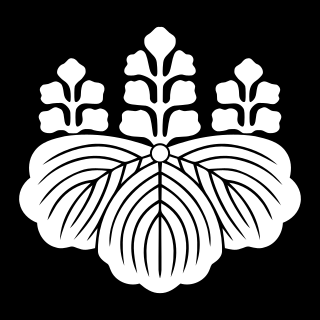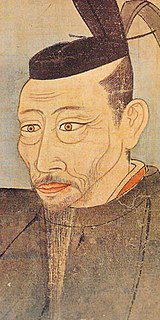
Toyotomi Hideyoshi was a preeminent daimyō, warrior, general, samurai, and politician of the Sengoku period who is regarded as Japan's second "great unifier". He succeeded his former liege lord, Oda Nobunaga, and brought an end to the Warring Lords period. The period of his rule is often called the Momoyama period, named after Hideyoshi's castle. After his death, his young son Hideyori was displaced by Tokugawa Ieyasu.

Tokugawa Ieyasu was the founder and first shōgun of the Tokugawa shogunate of Japan, which effectively ruled Japan from the Battle of Sekigahara in 1600 until the Meiji Restoration in 1868. Ieyasu seized power in 1600, received appointment as shōgun in 1603, and abdicated from office in 1605, but remained in power until his death in 1616. His given name is sometimes spelled Iyeyasu, according to the historical pronunciation of the kana character he. Ieyasu was posthumously enshrined at Nikkō Tōshō-gū with the name Tōshō Daigongen (東照大権現). He was one of the three unifiers of Japan, along with his former lord Nobunaga and Toyotomi Hideyoshi.
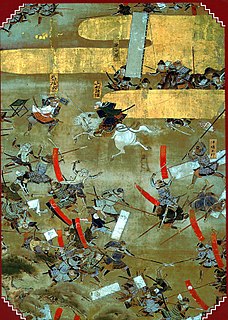
The Sengoku period is a period in Japanese history marked by social upheaval, political intrigue and near-constant military conflict. Japanese historians named it after the otherwise unrelated Warring States period in China. It was initiated by the Ōnin War, which collapsed the Japanese feudal system under the Ashikaga shogunate, and came to an end when the system was re-established under the Tokugawa shogunate by Tokugawa Ieyasu.

The Azuchi–Momoyama period is the final phase of the Sengoku period in Japan. These years of political unification led to the establishment of the Tokugawa shogunate. It spans the years from c. 1573 to 1600, during which time Oda Nobunaga and his successor, Toyotomi Hideyoshi, imposed order upon the chaos that had pervaded since the collapse of the Ashikaga shogunate.
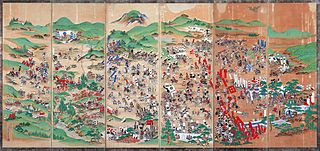
The Battle of Sekigahara was a decisive battle on October 21, 1600, that preceded the establishment of the Tokugawa shogunate.

Sanada Yukimura, actual name: Sanada Nobushige, was a Japanese samurai warrior of the Sengoku period. He was especially known as the leading general on the defending side of the Siege of Osaka.

Osaka Castle is a Japanese castle in Chūō-ku, Osaka, Japan. The castle is one of Japan's most famous landmarks and it played a major role in the unification of Japan during the sixteenth century of the Azuchi-Momoyama period.
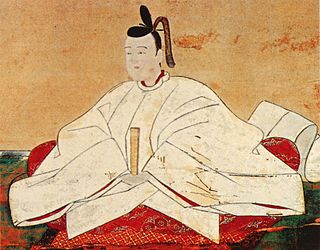
Toyotomi Hideyori was the son and designated successor of Toyotomi Hideyoshi, the general who first united all of Japan. His mother, Yodo-dono, was the niece of Oda Nobunaga.
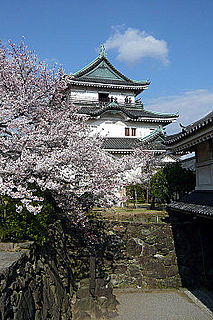
Wakayama Castle in Wakayama, Wakayama Prefecture, Japan, sits at the mouth of the Kii River. Originally Ōta castle, home of the Saiga Ikki, it was captured by Toyotomi Hideyoshi in 1585, during the Siege of Negoro-ji; many monks from Negoro-ji sought refuge in Ōta, which was soon destroyed by flood. Hideyoshi ordered the building of dams on three sides of the castle, focusing the rainwaters and diverting the river to ruin the castle. As hunger set in, the samurai, monks, and peasants inside Ōta surrendered, and fifty warrior monks led a final suicidal charge against Hideyoshi's army.

Yodo-dono (淀殿) or Yodogimi (淀君) was a prominently placed figure in late-Sengoku period. She was a concubine and second wife of Toyotomi Hideyoshi, who was then the most powerful man in Japan. She also became the mother of his son and successor, Hideyori. She was also known as Lady Chacha (茶々). After the death of Hideyoshi, she took the tonsure, becoming a Buddhist nun and taking the name Daikōin (大広院).

Asano Nagaakira was a Japanese samurai of the early Edo period who served as daimyō of Wakayama Domain, and was later transferred to the Hiroshima Domain.
The Battle of Kashii (樫井の戦い) was the very first battle of the Summer Campaign of the 1615 Siege of Osaka, near the beginning of the Edo period in Japan. It took place on the 26th day of the 4th month of the Keichō era.
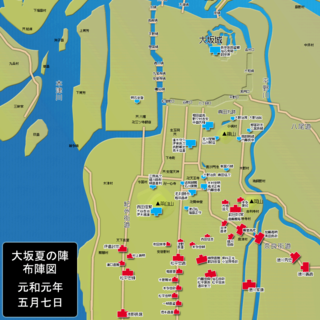
The Battle of Tennōji was fought in 1615 between the forces of Tokugawa Ieyasu and the forces of Toyotomi Hideyori. Tokugawa was laying siege to Osaka, and Hideyori had planned a counterattack. Both sides were plagued by mistakes until Hideyori's side finally fell. He presumably committed suicide. The Toyotomi army suffered nearly 50% casualties in this battle, with more than 15,000 dead. This was also the final battle of Sanada Yukimura.

The Battle of Shigino, fought in the final months of 1614, was one battle during the Siege of Osaka, a campaign by the Tokugawa shogunate to destroy or subjugate the last resistance to its power, the Toyotomi clan.
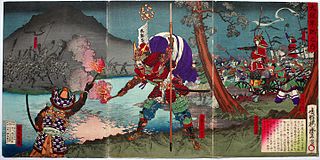
On June 3, 1615 the Eastern Army of Tokugawa Ieyasu and the Osaka Army of Toyotomi Hideyori clashed in battle at Dōmyōji, Osaka. This battle was one of Japan's major historical battles between samurai forces. This battle was one of a number of battles that took place during the Summer Campaign of the Siege of Osaka that led up to the fall of Osaka to the forces of Tokugawa and the death of Toyotomi Hideyori.
Mogami Yoshiaki was a daimyō of the Yamagata Domain in Dewa Province, in the late Sengoku and early Edo periods.
The Battle of Komaki and Nagakute was a series of battles in 1584 between the forces of Hashiba Hideyoshi and the forces of Oda Nobukatsu and Tokugawa Ieyasu. Hideyoshi and Ieyasu had both served Oda Nobunaga and had not previously come into conflict; this would in fact be their only period of enmity. Although this episode of history is most commonly known by the two largest and most important battles, the event is also sometimes referred to as the Komaki Campaign.

Maeda Matsu (前田まつ), also known as Omatsu no Kata (お松の方) (1547–1617), was a Japanese woman of the 16th century. She was the wife of Maeda Toshiie, who founded the Kaga Domain. Matsu had a reputation for intelligence; she was skilled at both literary and martial arts. She was eternalized for saving the Maeda clan from Tokugawa Ieyasu in Battle of Sekigahara and Siege of Osaka.



